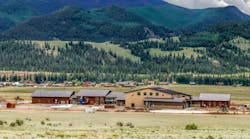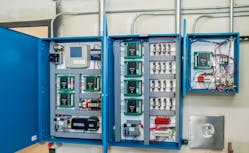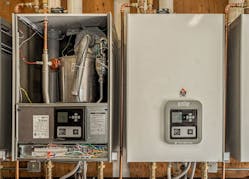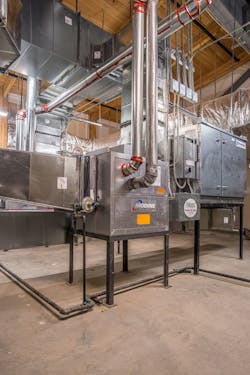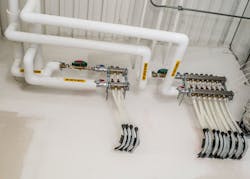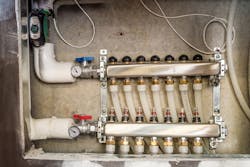The last of Colorado’s 19th-century silver boom towns, Creede has a colorful history. For instance, Robert Ford, the man who shot and killed outlaw Jesse James, was shot and killed in Creede in 1892. Yet despite the allure of the town’s past, Creede’s current residents maintain a contemporary existence. As of this year, they have a new K-12 school complete with modern, high-efficiency HVAC systems.
Project Goals
The general contractor, Fort Collins, Colo.-based Neenan Archistruction, broke ground on the 37,000-sq-ft school in May 2014. Two months later, Denver-based design-build HVAC firm Rogers & Sons Inc. reported to work.
With LEED Gold certification being sought, energy efficiency and low life-cycle costs were major criteria. Weather can be fickle in Creede. If a cold front moves in, the mercury can drop by 40°F in under an hour, and temperatures as low as −30°F are not unprecedented.
The job was made easier with a Taco iWorx control system featuring field-configurable sequences, yet not requiring programming. It allows all components to work in tandem while providing Web access.
Primary heat is supplied with four 399-MBH Triangle Tube condensing boilers and nearly seven miles of in-slab radiant tubing divided into 47 zones. Meanwhile, four RenewAire energy-recovery-ventilation (ERV) systems supply ventilation to 42 zones per ANSI/ASHRAE Standard 62.1, Ventilation for Acceptable Indoor Air Quality.
Sharing main trunk lines with the ERV units are propane-fired duct furnaces from Modine Manufacturing Co., which further temper makeup air during winter. Given Creede’s mild summers and low humidity, cooling is provided to only one meeting room and an information-technology closet.
Remote Controls
“The advantage of an iWorx system hits home for the building owner out here in the boondocks,” Shawn Metzler, controls superintendent for Rogers & Sons, said. “When they realize they don’t need a separate controls contractor—at the time of installation or going forward—they see value. Because of our use of iWorx controls, we’re a one-stop shop: HVAC and controls.
“There’s no code to write,” Metzler continued. “You don’t need special tools or software. Compared to a DDC (direct digital control) system, you eliminate a lot of hours typically spent programing and commissioning.”
Preprogrammed modules are used on equipment, zone valves, and dampers throughout the building. All components report back to a touchscreen local control interface in the boiler room. Each module self-identifies on the network when activated.
“Through the design phase, we used Taco’s iWorx Selection Wizard, which gives us a bill of material, sequence of operation, wiring diagram, and submittals,” Metzler said.
Another benefit, as far as the school was concerned, was that the first cost of an iWorx system is the last cost; there are no continuing fees associated with it, and software upgrades are free. Systems such as LON, BACnet, and Modbus interface easily with iWorx.
“If we have any technical questions, we call Peter Moore at McCoy Sales or directly to Taco support,” Metzler said. “Both have answered questions on the weekend.”
Radiant for the Rockies
To satisfy the building’s 1.2-million-Btu heating load, the well-insulated slab contains 3/4-in. Uponor crosslinked-polyethylene (PEX) tubing at 12-in. centers. Each classroom and common area has a small iWorx thermostat linked to the main network.
“The individual zones will ‘vote’ upon calling for heat,” Metzler said. “Because these zones are small, we’ve set up the controls so that any single zone can’t fire the boilers. Only numerous T-stats calling simultaneously will cause one or more of the boilers to start running.”
The four wall-hung boilers lead, lag, and rotate while providing 25-percent redundancy, a necessary insurance measure for a facility with epic winters and a half-day drive to/from the nearest supply house.
Despite requiring more time and effort, dozens of remote manifolds were hidden above the ceiling to eliminate access doors. Each stainless-steel manifold utilizes a low-kilowatt Taco Zone Sentry zone valve.
When the time to fill the radiant system arrived, the ground was frozen solid. Technicians called the fire department. Before long, a red tanker truck showed up at the site.
“It was the first time I’ve purged a system with a fire truck,” Aaron Ellis, head of field operations for Rogers & Sons, said. “It was the fastest fill we’ve seen!
“If ever there was a place for outdoor reset control, this is it,” Ellis continued. “Radiant supply temperatures will be anywhere between 80°F and 120°F. I think the record low in Creede is −45°F.”
For the same reasons, the school’s dedicated outdoor-air system (DOAS) is robust and flexible.
DOAS: ERV With a Sidekick
Two mechanical mezzanines house a variety of ventilation components that are independent of the hydronic heating system.
The four RenewAire ERV systems serve various parts of the building. Two of the units each have capacities of 2,500 cfm, while the other two each have capacities of 4,000 cfm. With variable-frequency-drive-powered fans, the units can modulate as low as 15 percent.
“A preprogrammed occupancy schedule ensures constant minimum ventilation while the building is in use,” Ellis said. “A VAVD iWorx module gathers data from CO2 sensors in each room. When the level reaches 1,000 ppm, the ERVs ramp up accordingly.”
To supplement each ERV, Rogers & Sons installed a separated-combustion Modine duct furnace.
“When the outdoor-air temperature falls below the ERVs’ ability to maintain supply air at 69°F, the Modine furnaces pick up the slack,” Metzler said. “We expect this to occur when outdoor temps hit 10°F.”
The duct furnaces were selected based on their flexibility in regard to installation and heat input. They supply a temperature rise from 20°F to 100°F, can modulate between 40 and 100 percent, and are available in sizes between 75 and 400 MBH.
Installed downstream of the ERV core, the duct furnaces fire only high enough to bring makeup air to neutral building temperature. As a result, ventilation is provided without an increase in radiant-system load.
Against the Grain
Despite the 530-mile commute to Creede and back, debilitating cold in the early stages of the project, and architectural considerations that made the job more complex, Rogers & Sons finished its work three weeks ahead of schedule, and the building was ready for students at the beginning of the 2015-2016 school year.
“This job went smoothly because of two key factors: careful preparation and familiarity with the products we selected,” Ellis said.
Dan Vastyan is an account manager for Common Ground, a trade-communications firm based in Manheim, Pa.
For Design Solutions author guidelines, call Scott Arnold, executive editor, at 216-931-9980, or write to him at [email protected].









